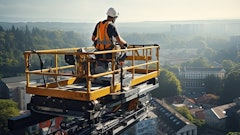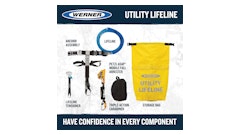
“People are always trying to gain time,” says Mark Ludewig, vice president of safety at AWP Safety. In doing so people try to find shortcuts throughout their day—unnecessary multitasking and distracted driving. According to CPWR: The Center for Construction Research and Training, struck-by incidents are the second leading cause of death among construction workers.
This research data is part of an August 2022 survey results report, “Struck-by Hazards, Barriers, and Opportunities in the Construction Industry.”
“I'll give you a perfect example,” says Ludewig. “On my way to work this morning, I passed one individual that had their tablet up on the dashboard and was watching the news. I passed a second individual that was applying makeup while driving. A third had a newspaper completely unfolded and sitting on the steering wheel driving down the road.”
Taking up the role as a traffic control partner for the construction industry, AWP Safety delivers comprehensive traffic management services, supporting projects from utility and broadband to infrastructure work across the county and specializes in supplying the manpower to guide traffic safety around work zones, as well as offering consultation, traffic design services, and any necessary traffic control equipment.
Listen to These Podcast Episodes on Work Zone Safety on ForConstructionPros.com
Improving Work Zone Safety Through Innovation - PSS International is delivering products to the industry that help to ensure every person arrives home safely at the end of the day.
Using Data to Improve Work Zone Safety - Connected vehicle technology can help project planners better manage these dangerous jobs.
As people try to take advantage of road time to accomplish other tasks, our roads and highways become more and more dangerous—especially for contractors working hard in work zones. According to a data bulletin published April 2021 by CPWR, struck-by incidents resulted in 170 deaths and more than 16,000 nonfatal injuries. AWP Safety looks at safety trends and attempts to forecast ahead based on incidents throughout the year. They use this analysis and attempt to identify more impactful solutions in work zone safety design. One of their recent solutions removes a flagger from traffic—a second provides a sacrificial mobile barrier to absorb the impact of incoming vehicles to save construction workers’ lives.
- Automated Flagger Assistance Devices (AFADS) is a mobile red and green light with an 8-ft. gate arm, controlled by an operator away from traffic in a vehicle.
- Truck Mounted Attenuators (TMAs) are shadow vehicles with a crush unit on the back of them designed to take the impact from a high or low-speed collision. “It’s another protection between workers and the motorists out there,” says Ludewig.
AWP works with construction companies by offering them a menu of options like specifics on how work zones are set up, strategic traffic control plans, rumble strips installed, barrels, safety equipment solutions, etc. “We have the ability to help them develop the work zone in the safest manner that they want,” says Ludewig. The company works with a lot of construction and paving companies. “If they have to shut a roadway down or even shut a sidewalk down to divert pedestrian or vehicle traffic, they have the ability to partner with us,” He adds that they’ll respond in kind to create the design, set up, and man the work zone to keep a construction company’s workers safe.
An Expert For A Reason
The first step in improving the safety of your next road construction project: ask for help – even if only in a supportive manner. And not only for road construction projects. There’s always an opportunity to be safer by bringing in a professional team as a partner who can help plan more effectively. “It’s the opportunity where you can bring in the professionals that do this for a living to help set up the zone,” says Ludewig.
He recommends, “rely on your partner. Rely on the people to do the things that they do well.”
Requesting for assistance can be scheduled early in the project or even the morning-of. For AWP Safety, no matter the job, each call includes a hazard evaluation and pre-job safety briefing where protectors evaluate and identify all hazards and attempt to eliminate them before work begins.
Among the multiple factors involved, safety experts will consider directional traffic, roadways, the type of project, if diverting traffic is necessary, lane closures, turning lanes, worker location—not to mention if any work is being done overhead or underground. Everything is considered for safety’s sake.
AWP Safety has measures in place to protect everyone— customers, clients as well as their own team members for each project. “Our team members are required to do pre-job briefings every single day, no matter what,” says Ludewig. Contractors are welcome to reach out to AWP for additional training. Their courses range from flagger training, providing OSHA 10- and 30-hour training, to first aid CPR.
For Ludewig, the biggest thing for contractors is awareness, taking that extra minute or two to step back from a situation and reevaluate to consider something they may have missed—and that something may save a life. “Taking an extra minute to evaluate the work zone, or working with a partner like AWP Safety that will come in and help address any of your needs – and considering any type of traffic control or necessary safety training,” he adds. “We are in the business of keeping people safe and that is exactly what we do.”
This awareness is what drives National Work Zone Awareness Week (April 17-21, 2023), traditionally held mid-April each year. Find resources and a calendar of events for the week at their website and through its partners and sponsors.





























